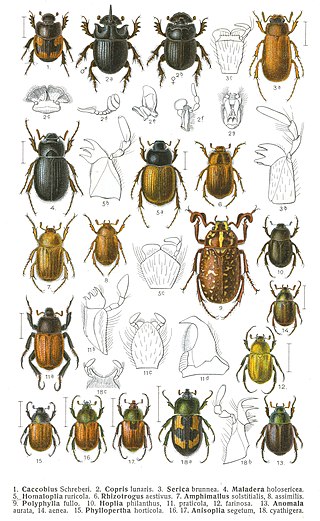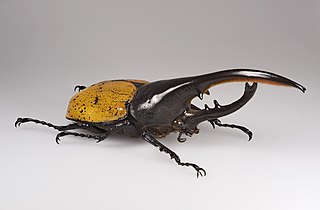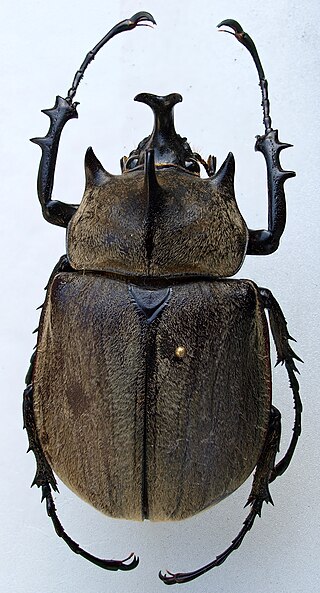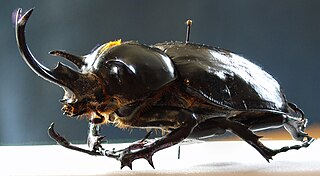
Beetles are insects that form the order Coleoptera, in the superorder Holometabola. Their front pair of wings are hardened into wing-cases, elytra, distinguishing them from most other insects. The Coleoptera, with about 400,000 described species, is the largest of all orders, constituting almost 40% of described insects and 25% of all known animal species; new species are discovered frequently, with estimates suggesting that there are between 0.9 and 2.1 million total species. Found in almost every habitat except the sea and the polar regions, they interact with their ecosystems in several ways: beetles often feed on plants and fungi, break down animal and plant debris, and eat other invertebrates. Some species are serious agricultural pests, such as the Colorado potato beetle, while others such as Coccinellidae eat aphids, scale insects, thrips, and other plant-sucking insects that damage crops. Some others also have unique characteristics, such as the common eastern firefly, which uses a light-emitting organ for mating and communication purposes

The family Scarabaeidae, as currently defined, consists of over 35,000 species of beetles worldwide; they are often called scarabs or scarab beetles. The classification of this family has undergone significant change in recent years. Several groups formerly treated as subfamilies have been elevated to family rank, and some reduced to lower ranks. The subfamilies listed in this article are in accordance with those in Catalog of Life (2023).

The Hercules beetle is a species of rhinoceros beetle native to the rainforests of southern Mexico, Central America, South America, and the Lesser Antilles. It is the longest extant species of beetle in the world, and is also one of the largest flying insects in the world.

Dynastinae or rhinoceros beetles are a subfamily of the scarab beetle family (Scarabaeidae). Other common names – some for particular groups of rhinoceros beetles – include Hercules beetles, unicorn beetles or horn beetles. Over 1,500 species and 225 genera of rhinoceros beetles are known.

Dynastes tityus, the eastern Hercules beetle, is a species of rhinoceros beetle native to the Eastern United States. The adult's elytra are green, gray or tan, with black markings, and the whole animal, including the male's horns, may reach 60 mm (2.4 in) in length. The larvae feed on decaying wood from various trees.

The flea beetle is a small, jumping beetle of the leaf beetle family (Chrysomelidae), that makes up the tribe Alticini which is part of the subfamily Galerucinae. Historically the flea beetles were classified as their own subfamily.

Allomyrina dichotoma, also known as the Japanese rhinoceros beetle or Japanese horned beetle, is a species of rhinoceros beetle. They are commonly found in continental Asia in countries such as China, the Korean peninsula, Japan, and Taiwan. In these areas, this species of beetle is often found in broad-leaved forests with tropical or sub-tropical climates. This beetle is well known for the prominent cephalic horn found on males. Male Japanese rhinoceros beetles will use this horn to fight other males for territory and access to female mating partners. Upon contact, males will attempt to flip each other onto their backs or off of their feeding tree. In response to selective pressures, smaller male A. dichotoma have adapted a "sneak-like behavior". These smaller beetles will attempt to avoid physical confrontation with larger males and try to mate with females.

The scarab beetle subfamily Scarabaeinae consists of species collectively called true dung beetles. Most of the beetles of this subfamily feed exclusively on dung. However, some may feed on decomposing matter including carrion, decaying fruits and fungi. Dung beetles can be placed into three structural guilds based on their method of dung processing namely rollers (telecoprids), dwellers (endocoprids) and tunnelers (paracoprids). Dung removal and burial by dung beetles result in ecological benefits such as soil aeration and fertilization; improved nutrient cycling and uptake by plants, increase in Pasture quality, biological control of pest flies and intestinal parasites and secondary seed dispersal. Well-known members include the genera Scarabaeus and Sisyphus, and Phanaeus vindex.

Strategus aloeus, the ox beetle, is a species of rhinoceros beetle native to the Americas.

Scarabaeus sacer, common name sacred scarab, is the type species of the genus Scarabaeus and the family Scarabaeidae. This dung beetle is native of southern Europe, northern Africa and western Asia, and it was venerated in ancient Egypt.

The elephant beetle is a member of the family Scarabaeidae and the subfamily Dynastinae. Elephant beetles are Neotropical rhinoceros beetles.

Goliathus regius, the Royal Goliath beetle, is a species of beetles of the family Scarabaeidae.

Actaeon beetle is a rhinoceros beetle of the family Scarabaeidae.

The long-tailed widowbird is a species of bird in the family Ploceidae. The species are found in Angola, Botswana, the Democratic Republic of the Congo, Kenya, Lesotho, South Africa, Eswatini, and Zambia. The long-tailed widowbird is a medium-sized bird and one of the most common in the territories it inhabits. Adult breeding males are almost entirely black with orange and white shoulders (epaulets), long, wide tails, and a bluish white bill. Females are rather inconspicuous, their feathers streaked tawny and black with pale patches on the chest, breast and back, narrow tail feathers, and horn-colored bills.

Eudicella gralli, sometimes called the flamboyant flower beetle or striped love beetle, is a brightly coloured member of the scarab beetle family, in the subfamily known as flower beetles. Their shells seem to have a prismatic quality, refracting the ambient light to give the green of their carapace a rainbow tint. This species of flower beetle lives in the rainforests of Africa, where it feeds on the nectar and pollen of flowers, but is popular in the exotic pet trade. The larvae of the flower beetle live in decaying wood, feeding on dead wood and leaf litter. Adults reach lengths of 25–40 millimetres (0.98–1.57 in). As in other species of this genus, the males have a Y-shaped horn, used to fight over females. The females have a shovel-like tusk, used for burrowing in wood. During their gestation period they will dig into the wood and lay eggs.

Megasoma is a genus of rhinoceros beetles. Commonly known as the elephant beetles, Megasoma species are found from the southern half of North America to most of South America.

Megasoma gyas is a species of large Neotropical rhinoceros beetles. There are no recognized subspecies.

Coprophanaeus ensifer is a large South American species of beetle belonging to the family Scarabaeidae. This species is necrophagous and builds burrows near or on animal carcasses to dismember the flesh of decaying bodies and bring it to its burrow to feed. Both females and males help build the burrow and feed. It is characterized by its iridescent colors and a horn that is similar in shape and size in females and males. It uses its horn to tear apart carcasses and to fight with other individuals, with male-male fighting occurring more often. However, females also fight to determine a variety of characteristics of the opposing male. This species may be of importance in forensic science due to its destructive behavior on decaying bodies, especially in areas of Brazil where homicide rates are high.

Oxysternon conspicillatum is a species of dung beetle in the family Scarabaeidae. It is found in both evergreen and semi-deciduous mesic forests, including disturbed habitats, ranging from near sea level to an altitude of 3,000 m (9,800 ft) in the Amazon basin and Chocó of tropical South America and Panama, possibly extending as far west as the border region with Costa Rica. Both adults and young of this common and widespread beetle primarily feed on dung, but the species has also been recorded feeding on dead animals.

Megasoma mars, also known as the mars beetle or mars rhino beetle, is the largest species in the Megasoma genus. It is distributed primarily in the west-central Amazon basin of Brazil, ranging down into Colombia, Paraguay, and Uraguay.





















